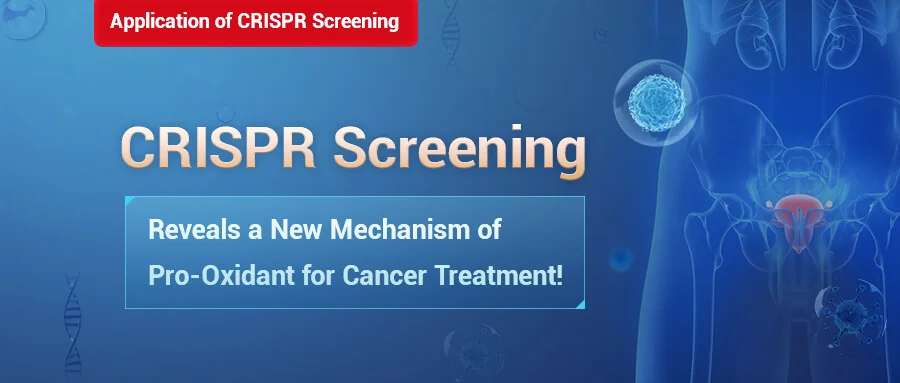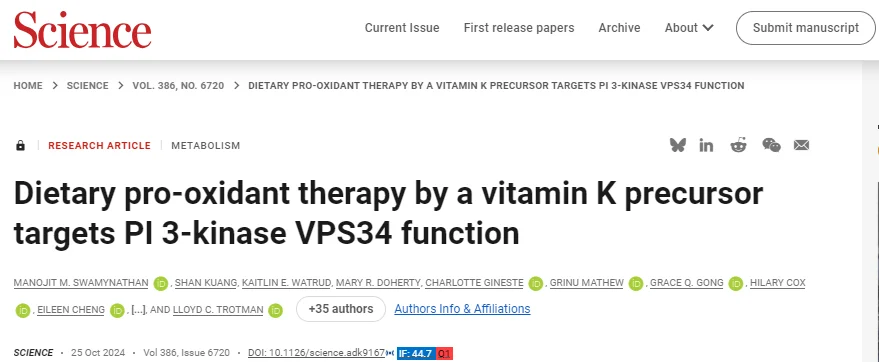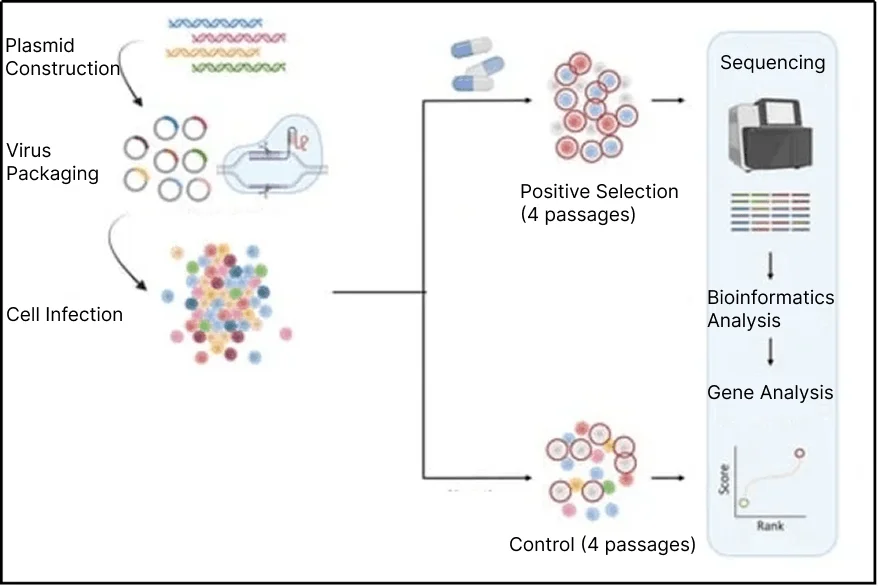CRISPR Screening Reveals a New Mechanism of Pro-Oxidant for Cancer Treatment!


CRISPR Screening Reveals a New Mechanism of Pro-Oxidant for Cancer Treatment!

Background
Prostate cancer is a prevalent cancer among men that can progress to metastatic and drug-resistant tumors. While antioxidant vitamin E was once hoped to be effective, large-scale trials (SELECT) but unexpectedly found an increased risk of cancer. This contradiction has prompted researchers to explore the potential anti-cancer properties of pro-oxidants. Manojit M. Swamynathan et al. published a paper titled “Dietary pro-oxidant therapy by a vitamin K precursor targets PI 3-kinase VPS34 function” in Science. Through the RapidCaP transgenic mouse model and a genome-wide CRISPR screening, they revealed that the pro-oxidant MSB induces a novel form of oxidative cell death (triaptosis) by targeting the VPS34 kinase, providing a new strategy for the treatment of prostate cancer.

Questions
Given the correlation between the use of antioxidant vitamin E and prostate cancer risk, could pro-oxidant supplementation help in preventing prostate cancer?
What is the mechanism through which the pro-oxidant (menadione sodium bisulfite, MSB) affects prostate cancer cells? What are the molecular targets?
Can pro-oxidants be applied as a potential therapeutic approach in treating prostate cancer, as well as other cancers and related diseases such as X-linked myopathy?
Main Methods
Animal Experiments: The RapidCaP transgenic mouse model was used to observe the inhibitory effect of pro-oxidant MSB on prostate cancer progression.The intensity and spread of prostate cancer were monitored by bioluminescence imaging (BLI).
Genomic Analysis: Whole-genome copy number variation (CNA) analysis of single nuclei from MSB-resistant RapidCaP mice was performed to identify and characterize resistance features and confirm the genetic dependencies of MSB-resistant cell lines.
CRISPR Screening: A whole-genome CRISPR screening composed of sensitivity and resistance screening was carried out to identify genes associated with the cytotoxic effects of MSB.
Main Conclusions
MSB significantly inhibits prostate cancer progression in mice (Fig. 1) by inducing a unique oxidative cell death mechanism known as triaptosis.

Fig. 1. MSB inhibits the development of prostate cancer in mice.
To identify the targets of MSB, the research group conducted a CRISPR screening using the Brunello CRISPR whole-genome knockout library (which includes 77,441 sgRNAs targeting 19,114 human genes). Each sgRNA was expressed in at least 1,000 PC3 cells, and both positive and negative selections were conducted to establish which gene knockouts increased or decreased PC3 sensitivity to MSB. The results suggest a potential pathway in understanding the action of MSB.

Fig. 2. CRISPR library construction, virus packaging and cell infection. Negative and positive selections were performed using low and high concentrations of MSB, respectively.
Through screening, it was found that the knockout of VPS15 increased sensitivity while the knockout of MTM1 decreased sensitivity of prostate cancer cells to MSB, indicating that VPS15 and MTM1 have oppositional roles regarding an early endosome’s PI(3)P marking process. This strongly suggests that MSB could directly target this biochemical reaction. The hypothesis is that MSB, as an oxidizing agent, oxidizes and inhibits the activity of related enzymes. Subsequent experiments supported the notion that MSB directly oxidizes a critical cysteine residue on VPS34, a type III phosphoinositide 3-kinase, thereby inactivating this enzyme responsible for producing PI(3)P.

Fig. 3. CRISPR screening strongly suggests that MSB acts on endosomal PI(3)P marking.
Moreover, can the specific inhibition of VPS34 by MSB be validated in other pathological models? In the X-linked myotubular myopathy model, the mutation loss of Mtm1, which antagonizes VPS34, disrupts the physiological balance of PI(3)P markings. The experiments showed that MSB treatment improved muscle histology and function while extending lifespan, likely because MSB suppressed VPS34 kinase activity, restoring PI(3)P levels to those conducive for improved muscle development.

Fig. 4. MSB can delay the progression of X-linked myotubular myopathy, possibly by inhibiting the activity of VPS34.
Summary and Outlook
This research revealed the potential of pro-oxidants in cancer treatment, especially for prostate cancer, which is common and difficult to treat. MSB can inhibit prostate cancer progression by targeting VPS34, providing a theoretical basis for new therapeutic strategies. The study also identified a new mechanism of selective action of pro-oxidants, working through specific redox-sensitive pathways, suggesting avenues for designing more precise pro-oxidant treatments that may offer unexpected therapeutic opportunities across various disease contexts.
Ubigene can provide the same library as the article - Brunello CRISPR whole-genome knockout library Plasmid / Virus / Screening-ready Cell Pool. We can also provide one-stop CRISPR screening services, as low as $8K, and as fast as 8 weeks to screen the target. Feel free to contact us!
Reference: Manojit M. Swamynathan et al. ,Dietary pro-oxidant therapy by a vitamin K precursor targets PI 3-kinase VPS34 function.Science386,eadk9167(2024).DOI:10.1126/science.adk9167.


